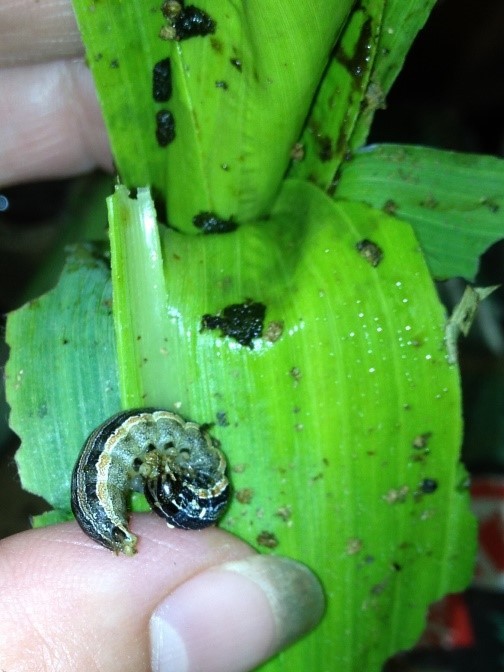True Armyworms Invading Sweet Corn!
Chuck Bornt, Team Leader, Extension Vegetable Specialist
Eastern New York Commercial Horticulture
This article was published in the June 7th 2018, ENYCHP Vegetable News. Click here to view the full newsletter.
The last two weeks have had us finding some True Armyworm adult moths in our traps. These moths move up from southern overwintering sites on storm fronts. If you recall, we've had some issues with these buggers in the past and sweet corn isn't their only host as we've seen them attack several vegetable crops including sweet corn, brassicas, tomatoes, peppers and greens. Not only is their damage a problem, but on things like lettuce, the droppings can affect marketability of the crop.
Armyworms, whether Fall or True, are very eager feeders and can do a lot of damage in a short time. Their feeding damage tends to appear ragged, with large holes eaten in the leaves and they leave lots and lots of sawdust looking frass (insect terminology for fecal matter). They tend to feed on the top sides of crops during the night and on the undersides or deeper into the plant during the day.
The adults are fairly large moths which are primarily nocturnal and have the ability to lay up to 2,000 eggs in their two week life. The eggs will hatch in 7 to 14 days and the larvae begin feeding immediately, going through seven stages of development over several weeks. The worms tend to be greenish brown (with some variations) with a pale white stripe on its back and an orange stripe on each side of the body. One other distinguishable feature is a dark brown to black triangle located on the outside of each of the four pairs of prologs found towards the hind end of the body.
Thresholds for when to treat corn have been established and should be treated when 25>#/b### of the plants are showing damage (Source: Integrated Pest Management Program, Missouri University). For sweet corn and leafy greens, best control is achieved when the larvae are small (1st and 2nd instar) and applied usually later in the evening when the larvae tend to be more active and feeding on the upper surfaces of the plants.
There are a number of insecticides labeled for leafy greens including these organic products: Pyganic (pyrethrin), Dipel (Bacillus thuringinensis, subsp. Kurstaki), Xentari ((Bacillus thuringiensis, var. aizawai), Aza-Direct (azadirachtin), Azera (pre-mix of azadirachtin and a pyrethroid) and Entrust (check the label for the labeled rates as formulations vary for these products). Again, these products are going to work best when applied to small larvae but if they get ahead of you, tank mixing a pyrethroid (Aza-Direct, Pyganic etc.) with a Bt (Dipel, Xentari etc) will improve performance. Repeat applications may also be necessary depending on how long the egg laying period and development conditions are.
Conventional insecticides labeled for armyworm control on sweet corn and leafy greens including Warrior II, Baythroid (both are recommended for 1st and 2nd instars), Coragen and Lannate. Ensure that you get thorough coverage, of the canopy with any of these products including the whorl in the case of sweet corn. Late evening applications also keep insecticides wet longer ensuring larval contact and ingestion of the insecticides. Other insecticides labeled for sweet corn include Asana XL (1st and 2nd instars), Mustang Max, Radiant SC and Blackhawk. Please check labels for rates.
 Note the ragged feeding and dark colored frass. (Photo: Teresa Rusinek)
Note the ragged feeding and dark colored frass. (Photo: Teresa Rusinek)
Upcoming Events
Ag Labor Road Show IX
December 1, 2025 : Save the Date! - Ag Labor Roadshow Webinar 1
In addition to the in-person Ag Labor Roadshow program in our region on December 9, two webinars are scheduled for December 1 and December 22. Each webinar will focus on different program content that is different from the in-person sessions. These webinars are an added benefit to program registration.
December 9, 2025 : Save the Date - Ag Labor Road Show In-Person Event (Greenwich, NY)
Greenwich, NY
The Roadshow delivers essential updates on labor law, regulations, and workforce best practices—tailored for farm owners, managers, and ag service providers. Sessions also focus on practical strategies to boost communication, strengthen retention, and build a positive workplace culture.
The in-person session for Eastern NY is December 9 - Elks Lodge, Greenwich, NY - full day in person session
Additional in-person sessions are:
December 10 - Hilton Garden Inn, Watertown, NY, December 17 - Cornell AgriTech, Geneva, NY, December 18 - Genesee Community College, Batavia, NY
December 22, 2025 : Save the Date! - Ag Labor Roadshow Webinar 2
In addition to the in-person Ag Labor Roadshow program in our region on December 9, two webinars are scheduled for December 1 and December 22. Each webinar will focus on different program content that is different from the in-person sessions. These webinars are an added benefit to program registration.
How to Obtain a Pesticide Applicator License
December 17, 2025
Thinking about becoming a certified pesticide applicator in New York, but aren't sure where to start? Join DEC representative Kenneth Klubek for a discussion on who needs to become a certified pesticide applicator, certification types, examination procedures, and recertification. Participants will have ample opportunity to ask questions during the program.
2026 Winter Cut Flower Webinar Series
January 6, 2026 : Session 1: Cut Flower Cost Calculator Updates and Woody Cuts
Session 1: Cut Flower Cost Calculator Updates and Woody Cuts
January 13, 2026 : Session 2: Perennials and Industry Trends
Session 2: Perennials and Industry Trends
January 20, 2026 : Session 3: Anaerobic Soil Disinfestation and Biochar
Session 3: Anaerobic Soil Disinfestation and Biochar
January 27, 2026 : Session 4: Beneficial Insects and Propagation Techniques
Session 4: Beneficial Insects and Propagation Techniques
February 3, 2026 : Session 5: Fungal and Insect Pests and Market Trends
Session 5: Fungal and Insect Pests and Market Trends












































